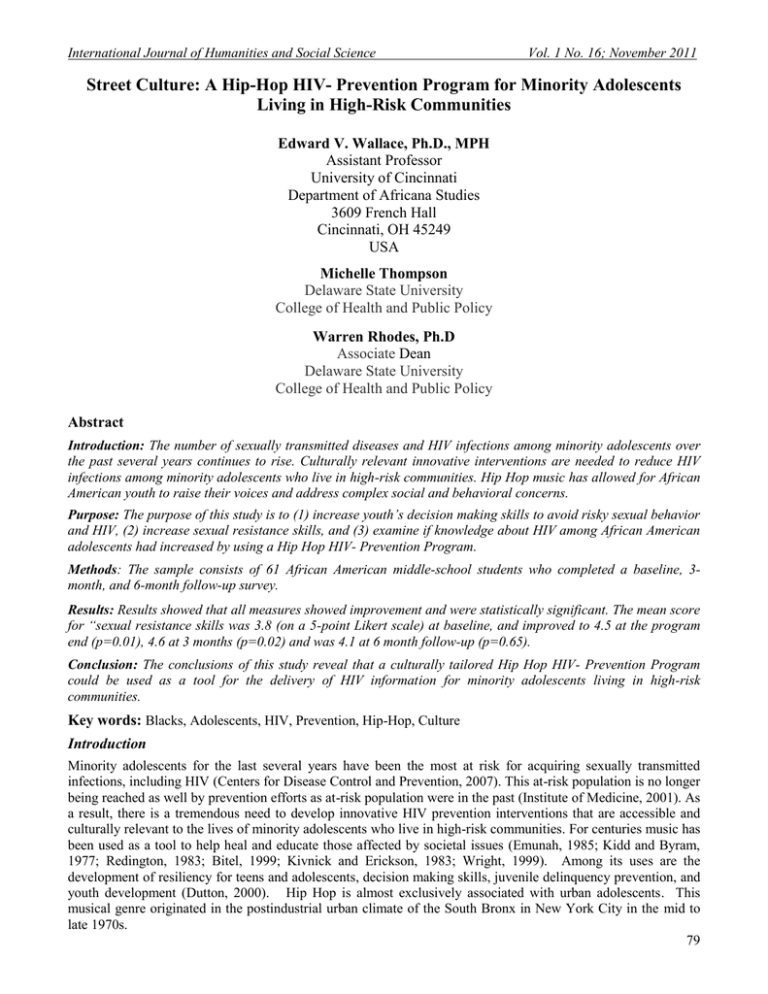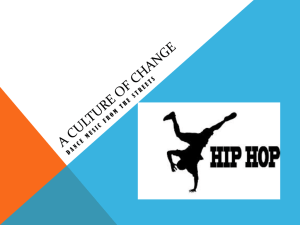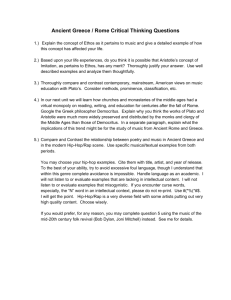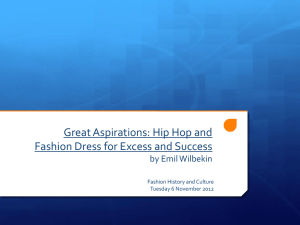
International Journal of Humanities and Social Science
Vol. 1 No. 16; November 2011
Street Culture: A Hip-Hop HIV- Prevention Program for Minority Adolescents
Living in High-Risk Communities
Edward V. Wallace, Ph.D., MPH
Assistant Professor
University of Cincinnati
Department of Africana Studies
3609 French Hall
Cincinnati, OH 45249
USA
Michelle Thompson
Delaware State University
College of Health and Public Policy
Warren Rhodes, Ph.D
Associate Dean
Delaware State University
College of Health and Public Policy
Abstract
Introduction: The number of sexually transmitted diseases and HIV infections among minority adolescents over
the past several years continues to rise. Culturally relevant innovative interventions are needed to reduce HIV
infections among minority adolescents who live in high-risk communities. Hip Hop music has allowed for African
American youth to raise their voices and address complex social and behavioral concerns.
Purpose: The purpose of this study is to (1) increase youth’s decision making skills to avoid risky sexual behavior
and HIV, (2) increase sexual resistance skills, and (3) examine if knowledge about HIV among African American
adolescents had increased by using a Hip Hop HIV- Prevention Program.
Methods: The sample consists of 61 African American middle-school students who completed a baseline, 3month, and 6-month follow-up survey.
Results: Results showed that all measures showed improvement and were statistically significant. The mean score
for “sexual resistance skills was 3.8 (on a 5-point Likert scale) at baseline, and improved to 4.5 at the program
end (p=0.01), 4.6 at 3 months (p=0.02) and was 4.1 at 6 month follow-up (p=0.65).
Conclusion: The conclusions of this study reveal that a culturally tailored Hip Hop HIV- Prevention Program
could be used as a tool for the delivery of HIV information for minority adolescents living in high-risk
communities.
Key words: Blacks, Adolescents, HIV, Prevention, Hip-Hop, Culture
Introduction
Minority adolescents for the last several years have been the most at risk for acquiring sexually transmitted
infections, including HIV (Centers for Disease Control and Prevention, 2007). This at-risk population is no longer
being reached as well by prevention efforts as at-risk population were in the past (Institute of Medicine, 2001). As
a result, there is a tremendous need to develop innovative HIV prevention interventions that are accessible and
culturally relevant to the lives of minority adolescents who live in high-risk communities. For centuries music has
been used as a tool to help heal and educate those affected by societal issues (Emunah, 1985; Kidd and Byram,
1977; Redington, 1983; Bitel, 1999; Kivnick and Erickson, 1983; Wright, 1999). Among its uses are the
development of resiliency for teens and adolescents, decision making skills, juvenile delinquency prevention, and
youth development (Dutton, 2000). Hip Hop is almost exclusively associated with urban adolescents. This
musical genre originated in the postindustrial urban climate of the South Bronx in New York City in the mid to
late 1970s.
79
© Centre for Promoting Ideas, USA
www.ijhssnet.com
Hip Hop involves taking vocal rhyming lyrics over a continuous musical beat provided by a disk jockey (DJ) who
uses a twin-turntable recording device to mix and “scratch” segments of existing vinyl records together to produce
an original musical sound (Back, 1996). Contrary to popular belief, not all Hip Hop music advocates death,
violence, or destruction. To a large extent, Hip Hop has been the consciousness-raising voice of African American
urban youth, addressing issues as complex as the psychological concerns of personal identity and sociological
concerns of racial inequality. Research on HIV-prevention suggests that to be effective interventions must (a) be
tailored to the study population or culture and (b) have a theoretical basis (National Campaign to Prevent Teen
Pregnancy, 2001). Therefore, Hip Hop has potential as a format for delivery of HIV-prevention information to
African American adolescents.
Theoretical Framework
A life course/social field theoretical orientation (Kellum and Rebok, 1992) provides the contextual framework for
the current study. The framework suggests that success in responding to various social demands encountered
during the early life course is linked to the individual’s concurrent and later social and psychological well-being.
Accordingly, successful social adaptation is hypothesized to promote better adaptation to demands across various
social fields. For adolescents these social fields include peers, family, and the school environment. Within a life
course perspective, key transitional periods may increase vulnerability to risky behaviors and poor adaptation.
African American urban adolescents who are transitioning from the more sheltered elementary school
environment to middle school may be at greater risk for engagement in risky behaviors (e.g., unprotected sex) and
associated negative outcomes (e.g., HIV/AIDS). Among the risk factors associated with negative outcomes for
African American urban youth are poor parent/family/school bonding, negative peer influences, and early sexual
initiation. The purpose of this study is to (1) increase youth’s decision making skills to avoid risky sexual
behavior and HIV, (2) increase sexual resistance skills, and (3) examine if knowledge about HIV among African
American adolescents had increased by using a Hip Hop HIV- Prevention Program.
Methods
Participants
Participants included 22 African American males and 39 African American females who completed a survey
containing selected questions about drugs, HIV/AIDS and sexual activity. The mean age of participants was 13
years (SD = .89). Sixty-three percent of the participants were in 8th grade and 33% were in 7th grade (Table 1).
Table 1. Demographic Profile of the sample
Variable
Age
12 years old
13 years old
14 years old
Percent
21.3
55.7
23.0
Sex
Male
Female
36.1
63.9
Grade
7th Grade
8th Grade
9th Grade
33.3
63.3
3.3
Recruitment
The Hip Hop HIV- Prevention Program took place in Prince George’s County, MD school district (and was)
designed for low-income families living in multi-family rental housing. The planning, implementation, and
evaluation of the Hip Hop HIV- Prevention Program was a collaborative effort by a curriculum developer,
evaluation director, program director, project manager, an advisory committee and eight curriculum instructors.
80
International Journal of Humanities and Social Science
Vol. 1 No. 16; November 2011
Participant recruitment for actual participation in the Hip Hop HIV- Prevention Program began in late winter
2008 with mailings to parents of students who had attended the various Hip Hop HIV- Prevention sponsored
events and expressed interest in participating in the Hip Hop HIV- Prevention Program at one of the parent
orientation dinner meetings where they learned about and had an opportunity to registrar for the Hip Hop HIVPrevention.
The Program
The overall program goals for this particular study was to (1) increase youth’s decision making skills to avoid
risky sexual behavior and HIV, (2) increase sexual resistance skills, and (3) increase knowledge about HIV. The
Hip Hop HIV- Prevention Program is unique in that it is technology-driven and uses a characteristic original art
form of dominant youth culture to effectively communicate prevention messages. Faculty members from the host
school were trained as Hip Hop HIV prevention instructors. Prior to implementation of the Hip Hop HIVPrevention Program, faculty and staff participated in Hip-Hop 101, a 4-hour hip-hop workshop, as a staff training
experience during an in-service retreat for all teachers and staff. The workshop was designed to increase faculty
and administrator knowledge and understanding of hip-hop, and to explore ways that hip-hop could enhance what
these educators were already doing to increase student learning in the classroom environment.
The Hip Hop HIV-Prevention lectures were implemented at a local middle school in Prince George’s County for
an 8 week period. The local middle school was chosen, due to the strong family and community commitment to
increase knowledge and HIV awareness. The lectures emphasized resistance skills, information on sexual
behavior, and knowledge on HIV/AIDS. The 8-week Hip Hop HIV- Prevention Program consisted of structured
classroom sessions. The classroom time included an opportunity for students to role-play sex resistance skills,
create a “rap”, and participate in group discussions about HIV prevention.
Hip Hop HIV Prevention Activity
Hip Hop HIV instructors and participants were divided into three or four instructional groups, with male and
female participants in each group. The groups met separately in assigned areas to create Hip Hop HIV ciphers
where they were given the task to create a “rap battle” using age-appropriate fact-sheets and pamphlets with well
vetted information about HIV from reputable organizations such as the Centers for Disease Control and
Prevention and the National Institutes of Health. The “rap battle” which is an artful rap presentation clearly
demonstrated the creativity, camaraderie, and knowledge engendered by the Hip Hop HIV Prevention Program.
This experience is demonstrated in the following “rap” statement:
If I ever meet a girl and I want to make love I clearly understand that I need to wear a
glove [condom]. Young, Black, and talented that’s who I am I cannot afford t catch the
HIV virus because that’s a death sentence man.
My mother always told me I could be whatever I wanted to be, well if this is true I need to
follow the guidelines of the CDC. The HIV Prevention program gave me some knowledge
and increased my skills, so from one person to another please understand that AIDS kills.
The Hip Hop HIV instructors served as mentors and facilitated the structured classroom-time activities to ensure
that the “rap battle” and the classroom activities were aligned with the program goals.
Program Evaluation
Each session of the Hip Hop HIV- Prevention Program was evaluated formally and informally. Impact evaluation
was measured using baseline, 3-month, and 6-month follow-up. Participants were asked to fill out a brief
baseline questionnaire assessing decision making skills, sexual resistance skills and knowledge about HIV/AIDS
at the beginning and the end of the HIV/Prevention Program (Table 2). To encourage participants to fill out the
baseline surveys, participants were informed about an incentive for completing the survey (amusement park
tickets) and the privacy protections in place to ensure confidentiality of the participants’ identities and survey
responses. To encourage post-test completion, facilitators collected the surveys before they distributed tickets for
the Six Flags amusement park.
Results
All measures showed improvement and were statistically significant: decision making skills, sexual resistance
skills and HIV Knowledge (Table 2).
81
© Centre for Promoting Ideas, USA
www.ijhssnet.com
These improvements were sustained at 3-months and began to decrease slightly at 6 months. For example, the
mean score for “sexual resistance skills was 3.8 (on a 5-point Likert scale) at baseline, and improved to 4.5 at the
program end (p=0.01), 4.6 at 3 months (p=0.02) and was 4.1 at 6 month follow-up (p=0.65).
Table 2. Decision making skills, Sexual resistance, and HIV Knowledge at Baseline, 3-month, and 6-month
follow-up.
Measures
Baseline
Program
End
4.5
P-value
3-month
Follow-up
4.4
p-value
6-month
Follow -up
4.3
0.04
0.04
Decision Making 3.9
Skills
3.8
4.5
0.01
4.6
0.02
4.1
Sexual
Resistance Skills
3.9
4.2
0.28
4.4
0.16
4.1
HIV
Knowledge
P-values represent comparisons between baseline values and subsequent time points. Mean scores
P-values are based on Wilcoxon signed-rank tests.
Significant p < 0.05
p-value
0.32
0.65
0.65
are presented.
Discussion
This study examined how a Hip Hop HIV- Prevention program could (1) increase youth’s decision making skills
to avoid risky sexual behavior, (2) increase sexual resistance skills, and (3) increase knowledge about HIV. The
Hip Hop HIV - Prevention Program’s development had several strengths, most important was the collaboration
between the advisory committee, curriculum developer, evaluation director, program director, project manager,
and eight college curriculum instructors. The health promotion research team was able to implement this project
because we were able to maintain a respectful and open cultural approach, make sure the environment was safe
and non-threatening, and develop trust within the school system and in the community at large. The advisory
committee was able to provide valuable insight about the target population and their families. The curriculum
developer was able confirm that lessons during the sessions were age appropriate and comprehensive for those
involved in the study. The project manager was able to ensure that the project adhered to the timeline outlined
for the study. The evaluation director upheld the ethical standards for the study for baseline and post-test surveys.
The curriculum instructors were able to contribute information about the target population and provide space in
the school in which the program took place.
Program participants increased their decision making skills, sexual resistance skills and knowledge about HIV
from the lectures of the Hip Hop HIV- Prevention Program. Our study is similar to that of other researcher.
Kirby et al (2006) found that middle school children who participated in an HIV prevention program increased
their knowledge about HIV, delay of sexual initiation and pregnancy. Despite the many strengths of the Hip
Hop HIV Prevention Program, the study itself had many limitations that must be considered. First, there was a
small sample size making it difficult to generalize our findings. Second, students that participated in the study
were recruited from only one school in Prince George's County, MD; further study is needed to assess the broad
applicability of these findings. Third, the analysis did not control for external factors that may have had an impact
on our findings. It is quite possible that participants in the study could have received additional HIV information
from their parents and the media.
Despite these limitations the need to implement a culturally sensitive program for minority adolescents is crucial.
Findings from similar studies with a culturally sensitive focus (Osemene, et al, 2001), concluded that any
HIV/AIDS reduction program for minority communities must include culturally sensitive interventions. Since
Hip Hop or "rap music" was created in the late 1970s billions of Hip Hop songs are now downloaded from the
internet and purchased each day, yet little is known about how the Hip Hop culture can transmit knowledge about
HIV in high risk communities. The Hip Hop HIV- Prevention Program makes an important contribution for
African American adolescents in Prince George's County, MD, but further research should be explored to see the
impact of Hip Hop culture can have on understanding HIV transmission at the national and international level
since Hip Hop over the years has become more "mainstream" and is no longer considered to be specifically for
inner city youth.
82
International Journal of Humanities and Social Science
Vol. 1 No. 16; November 2011
References
Back, L. (1996), New Ethnicities and Urban Culture: Racism and multicultural in young lives. London: UCLA
Press.
Bitel, M. (1999, Mixing up the goulash: Essential ingredients in the “Art” of social groupWork. Social Work
with Groups, Vol. 22 No 2, pp 77-99.
Centers for Disease Control and Prevention. (2007), HIV/AID Surveillance report: HIV infection and AIDS in the
United States and dependent areas, 2005. http://www.cdc.gov/hiv/topics/surveillance/basic.htm (accessed
15 December 2010).
Dutton, S. E. (2001), Urban youth development Broadway style: Using theater and group work as vehicles of for
positive development. Social Work with Groups, Vol. 23 No 4, pp. 20-39.
Emaunah, R. (1985), Drama therapy and adolescent resistance. The Arts of Psychotherapy,Vol. 12, pp. 71-79.
Grinstead O, Zack B,and Faigeles B. (1999), Reducing postrelease risk behavior among HIV seropositive prison
inmates: the Health Promotion Program. AIDS Education and Prevention, Vol. 13, pp. 109-119.
Institute of Medicine. (2001), No time to lose: Getting more from HIV prevention. Washington, DC: National
Academy of Sciences.
Kellum, S. and Rebok, G. (1992), Building developmental and etiological theory through epidemiologically
based preventive intervention trials. In J. McCord & R. Tremblay (Eds.), Preventing antisocial behavior:
Interventions from birth through adolescence (pp. 162-195). New York: Guilford Press.
Kidd, R., and Byram, M. (1977), A botswana case study: Popular theatre and development Convergence, Vol. 10,
pp. 20-30.
Kirby, D., Laris, B., and Rolleri, L. (2006). Sex and HIV Education Programs for Youth: Their Impact and
Important Characteristics. International Journal of Family Health, Vol. 1 pp.1-77.
Kivnick, H. and Erickson. J. (1983), The arts as healing. American Journal of Orthopsychiatry,Vol. 53 No 4, pp.
603-608.
National Campaign to Prevent Teen Pregnancy. (2001), Faithful nation: What American adults and teens think
about faith, morals, religion, and teen pregnancy. Washington, DC:
Osemene, N. I., Essien, J., and Egbunike, G. (2001), HIV/AIDS behind bars: an avenue for culturally sensitive
interventions. Journal of National Medical Association Vol. 93 No 12, pp. 481-486.
Redington, C. (1983), Can theatre teach? An historical and evaluative analysis of theatre education. Oxford,
England: Pergamon Press Ltd.
83




